minolta maxxum 7000 af manual
- by leo

Welcome to the Minolta Maxxum 7000 AF manual‚ your comprehensive guide to mastering this iconic SLR camera. This manual provides detailed instructions for optimal use‚ ensuring you unlock all its advanced features‚ from autofocus to exposure modes‚ and troubleshooting tips for seamless photography experiences.
Historical Significance of the Minolta Maxxum 7000
The Minolta Maxxum 7000‚ released in 1985‚ holds a pivotal place in photography history as the world’s first SLR camera with an integrated autofocus system. This revolutionary design set the standard for future cameras‚ blending advanced technology with user-friendly features. Its introduction marked a significant shift in the industry‚ influencing both film and digital camera development. The Maxxum 7000’s autofocus system‚ combined with its PASM modes and predictive focus control‚ made it a favorite among professionals and enthusiasts alike. Its impact extended beyond film photography‚ shaping the design and functionality of modern digital SLRs. As a landmark camera‚ the Maxxum 7000 remains a celebrated milestone in photographic innovation‚ embodying the transition from manual to automated systems that defined the evolution of photography in the late 20th century.
Importance of the Manual for Optimal Camera Use
The Minolta Maxxum 7000 AF manual is an indispensable resource for photographers seeking to unlock the full potential of their camera. It provides detailed insights into the camera’s advanced features‚ such as its autofocus system‚ exposure modes‚ and metering options. Without the manual‚ users may struggle to understand how to customize settings or troubleshoot common issues. The guide offers step-by-step instructions for optimizing performance‚ ensuring that photographers can achieve precise control over their shots. Whether adjusting ISO settings‚ utilizing flash options‚ or exploring creative modes‚ the manual serves as a comprehensive roadmap. It also helps users maintain the camera’s longevity through proper care and maintenance. By referring to the manual‚ photographers can maximize their creative output and enjoy a seamless shooting experience with the Minolta Maxxum 7000 AF.
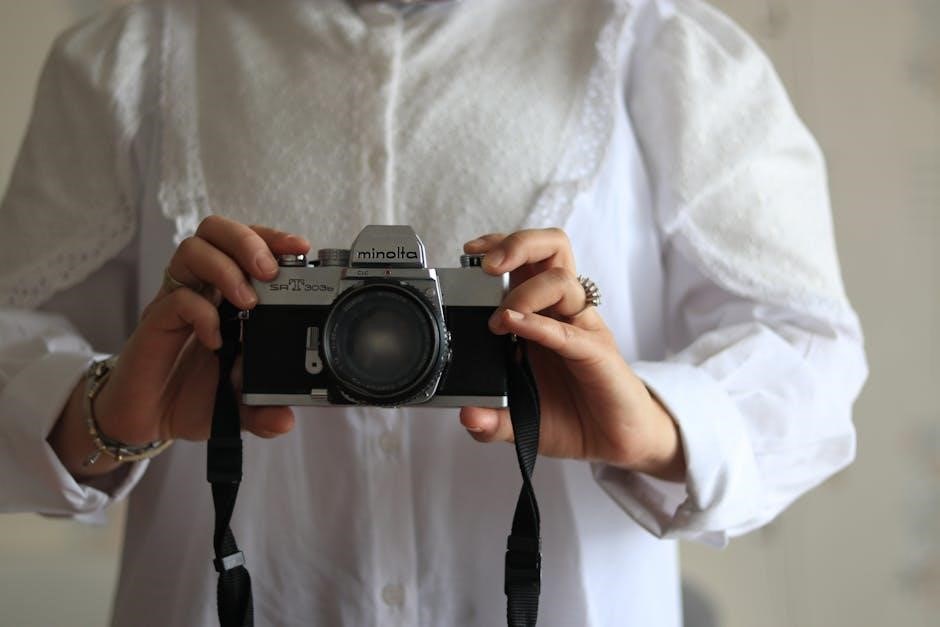
Camera Overview and Features
The Minolta Maxxum 7000 AF is a groundbreaking 35mm film SLR featuring advanced autofocus‚ durable construction‚ and intuitive controls‚ making it a favorite among professionals and enthusiasts alike.
Key Specifications of the Minolta Maxxum 7000
The Minolta Maxxum 7000 AF features a 35mm film format‚ 35mm lens mount‚ and a robust autofocus system. It offers a shutter speed range of 1/4000 to 30 seconds‚ with a flash sync speed of 1/200 seconds. The camera supports ISO settings from 25 to 5000‚ with center-weighted and spot metering modes for precise exposure control. Its built-in flash provides a guide number of 12 at ISO 100‚ and it supports external flash units via a hot shoe. The viewfinder offers 90% coverage with a 0.75x magnification for accurate framing. The camera is compatible with Minolta AF lenses‚ ensuring versatility for various photography needs. Its durable design and user-friendly interface make it suitable for both professionals and enthusiasts‚ while its advanced features set it apart in the world of film photography.
Autofocus System and Its Capabilities
The Minolta Maxxum 7000 AF is renowned for its advanced autofocus system‚ which was groundbreaking at its release. Equipped with a multi-zone autofocus sensor‚ it offers quick and precise focusing even in challenging lighting conditions. The camera features predictive autofocus‚ enabling it to track moving subjects effectively. The autofocus system works seamlessly with Minolta AF lenses‚ ensuring compatibility and optimal performance. Users can switch between single-shot AF and continuous AF modes‚ catering to various shooting scenarios. The system is also relatively quiet and fast‚ making it suitable for both candid and action photography. Additionally‚ manual focus override is available‚ allowing photographers to fine-tune focus without switching modes. This robust autofocus system enhances the camera’s versatility and makes it a reliable choice for capturing sharp images effortlessly.
Exposure Modes: PASM (Program‚ Aperture Priority‚ Shutter Priority‚ Manual)
The Minolta Maxxum 7000 AF offers a comprehensive suite of exposure modes‚ providing photographers with precise control over their shots. The Program Mode (P) automatically adjusts aperture and shutter speed for effortless point-and-shoot photography. Aperture Priority Mode (A) allows users to set the aperture‚ with the camera automatically adjusting the shutter speed to maintain proper exposure. Shutter Priority Mode (S) enables manual control over shutter speed‚ ideal for capturing motion effects. Manual Mode (M) grants full creative control‚ letting photographers independently adjust both aperture and shutter speed. These modes are easily accessible via the camera’s mode dial‚ ensuring quick adjustments. The PASM system caters to photographers of all skill levels‚ from beginners relying on automation to professionals seeking fine-tuned control. This versatility makes the Maxxum 7000 AF a flexible tool for diverse photographic scenarios‚ ensuring optimal results in various lighting conditions.
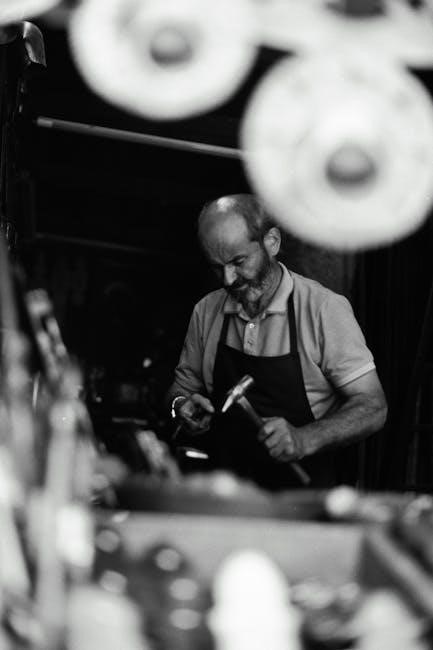

Autofocus and Metering
The Minolta Maxxum 7000 AF features an advanced autofocus system and precise metering modes‚ ensuring sharp focus and accurate exposure for exceptional image quality every time.
Understanding the Autofocus Mechanism
The Minolta Maxxum 7000 AF is equipped with a revolutionary autofocus system that relies on infrared beams to quickly and accurately focus on subjects. When the shutter button is pressed halfway‚ the camera emits infrared light‚ which reflects off the subject and returns to the camera. This light is then detected by sensors‚ allowing the camera to calculate the distance and adjust the lens accordingly. The autofocus mechanism is highly responsive‚ making it ideal for capturing sharp images in various lighting conditions. Additionally‚ the system supports both single-shot and continuous autofocus modes‚ catering to different shooting scenarios. The autofocus feature significantly reduces the risk of camera shake and missed shots‚ ensuring precise focus even with moving subjects. For optimal results‚ users are encouraged to familiarize themselves with the autofocus settings and customize them according to their photography needs.
Metering Modes: Center-Weighted and Spot Metering
The Minolta Maxxum 7000 AF offers two primary metering modes: Center-Weighted Average and Spot Metering. Center-Weighted Average Metering is the default mode‚ providing a balanced exposure by averaging light from across the entire frame‚ with emphasis on the central area. This mode is ideal for everyday photography‚ as it works well for most scenes. Spot Metering‚ on the other hand‚ measures light from a small‚ centrally located spot (approximately 5% of the viewfinder area)‚ allowing precise control over exposure for specific subjects or areas. This mode is particularly useful in high-contrast situations or when capturing subjects with unique lighting requirements. Both modes can be easily toggled using the camera’s controls‚ giving photographers flexibility to adapt to various lighting conditions and creative needs. Understanding these metering options is crucial for achieving accurate exposures and enhancing the overall quality of images.
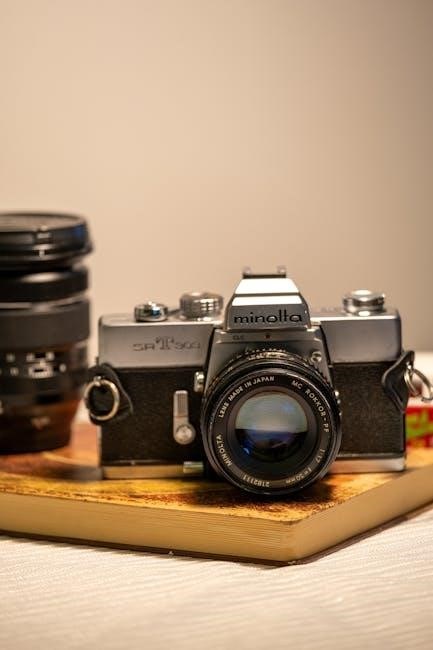
Exposure Control and Settings
The Minolta Maxxum 7000 AF offers precise exposure control through ISO settings‚ aperture‚ and shutter speed. These settings enable photographers to achieve desired effects in various lighting conditions.
ISO Settings and Film Handling
The Minolta Maxxum 7000 AF allows photographers to adjust ISO settings from 25 to 5000 in 1/3-stop increments‚ providing flexibility for various lighting conditions. The camera supports DX-coded film‚ automatically detecting and setting the ISO based on the film cartridge. For non-DX films or custom adjustments‚ manual ISO override is available. This feature ensures optimal exposure control‚ catering to both automatic and manual workflows. The camera also handles 35mm film efficiently‚ with auto film advance and rewind capabilities. Additionally‚ the Maxxum 7000 supports mid-roll rewind‚ allowing photographers to change film without finishing the roll. These features make it a versatile tool for film photography‚ balancing convenience with creative control. Understanding ISO settings and film handling is essential for maximizing the camera’s potential in different photographic scenarios.
White Balance and Custom Settings
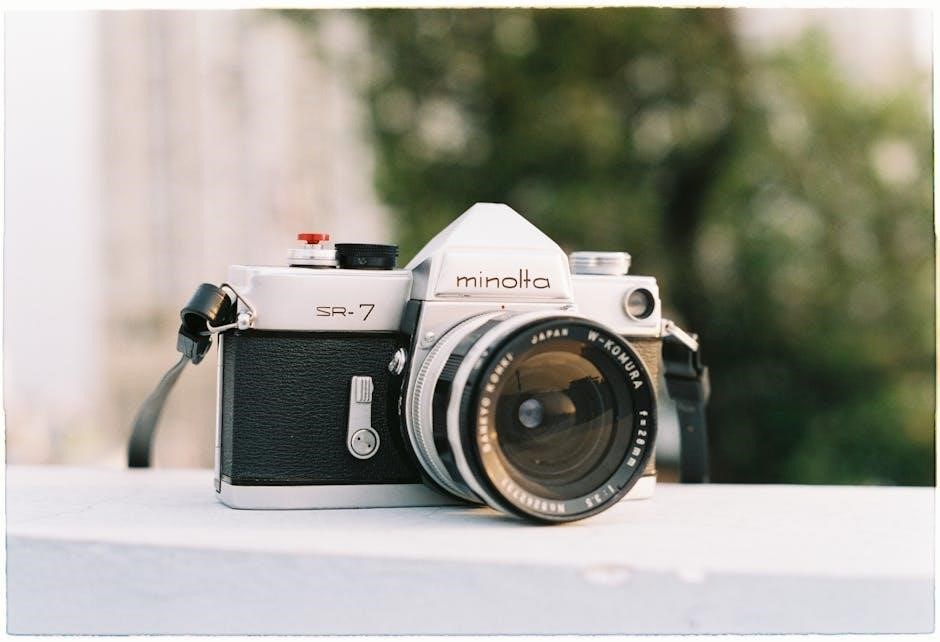
The Minolta Maxxum 7000 AF offers versatile white balance options tailored for film photography. While it doesn’t have digital white balance presets like modern cameras‚ it supports film-specific solutions‚ such as daylight‚ tungsten‚ and fluorescent film emulsions. Photographers can also use color correction filters to achieve precise white balance. Custom settings are accessible via the camera’s control panel‚ allowing adjustments to exposure compensation‚ metering modes‚ and flash output. Users can save preferred settings for quick access‚ enhancing shooting efficiency. These features empower photographers to adapt to various lighting conditions and maintain consistent results. By leveraging film type selection and filters‚ the Maxxum 7000 provides creative control over white balance‚ making it a flexible tool for film enthusiasts. Understanding these settings ensures optimal image quality and personalization in different photographic environments.
Flash and External Lighting Options
The Minolta Maxxum 7000 AF is equipped with a built-in flash‚ offering TTL (Through-The-Lens) metering for precise illumination. This feature ensures balanced lighting in various conditions‚ with options like red-eye reduction and rear-curtain sync. For external lighting‚ the camera supports Minolta’s dedicated flash units via the hot shoe and PC sync terminal. External flashes provide greater power and flexibility‚ enabling advanced lighting setups. The Maxxum 7000 also allows for multiple flash units to be connected‚ enhancing creative control over lighting. This adaptability makes it ideal for studio and location photography. By combining built-in and external flash options‚ photographers can achieve professional-grade results with ease. These features underscore the camera’s versatility in handling diverse lighting challenges‚ making it a robust choice for both amateur and professional photographers seeking precise control over their lighting setups.
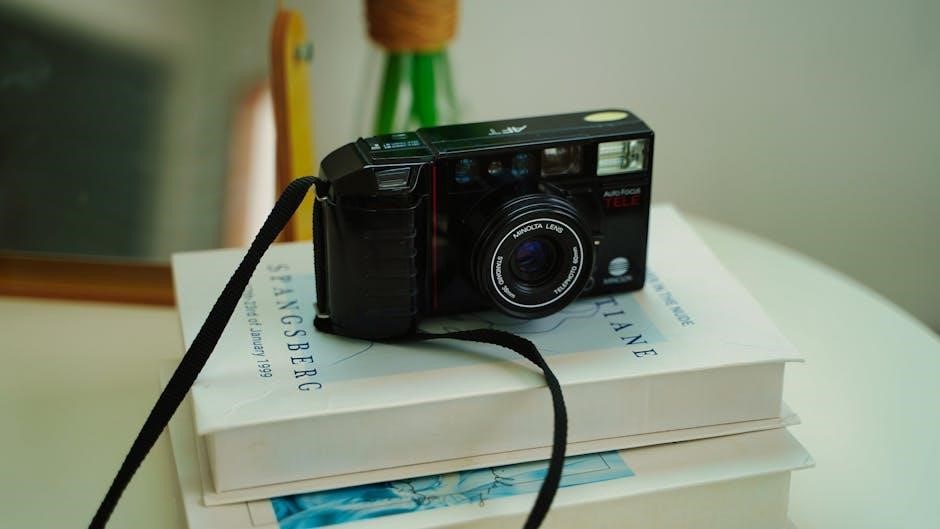
Additional Features and Accessories
The Minolta Maxxum 7000 AF supports motor drives‚ remote controls‚ and interchangeable lenses‚ enhancing versatility. Accessories like battery grips and cases extend functionality‚ catering to professional and hobbyist needs.
Motor Drive and Remote Control Compatibility
The Minolta Maxxum 7000 AF is compatible with motor drives‚ enabling high-speed continuous shooting. The Minolta Motor Drive 600 is a popular accessory‚ offering up to 5 fps burst mode. This feature is ideal for capturing fast-moving subjects and reduces camera shake during rapid shooting. Additionally‚ the camera supports remote control functionality‚ allowing photographers to trigger the shutter without physical contact‚ minimizing vibrations. The Minolta Remote Controller uses infrared signals for reliable operation‚ making it a valuable tool for studio‚ landscape‚ or macro photography. These accessories enhance the camera’s versatility‚ catering to professional and advanced photographers who require precise control and speed. The motor drive and remote control compatibility ensure the Minolta Maxxum 7000 remains a powerful tool for capturing dynamic and high-quality images.
Lens Compatibility and Minolta AF Lenses
The Minolta Maxxum 7000 AF is fully compatible with Minolta’s A-mount lenses‚ ensuring a wide range of creative possibilities. The camera supports Minolta AF (auto-focus) lenses‚ which are renowned for their optical quality and reliability. With a vast selection of lenses available‚ photographers can choose from standard zooms‚ wide-angle primes‚ telephoto zooms‚ and specialized lenses like macro and fisheye. The A-mount system allows seamless communication between the camera and lens‚ enabling advanced features like autofocus and aperture control. Additionally‚ the Maxxum 7000 can use manual-focus Minolta lenses‚ though with reduced functionality. This compatibility makes the camera a versatile tool for photographers‚ offering flexibility and adaptability across various shooting scenarios. Minolta AF lenses are designed to deliver sharp images and accurate color rendition‚ making them an excellent choice for both professionals and enthusiasts.
Battery and Power Management
The Minolta Maxxum 7000 AF is powered by four AA batteries‚ offering reliable performance for extended shooting sessions. For optimal use‚ it is recommended to use high-quality alkaline or nickel-metal hydride (NiMH) batteries‚ as they provide consistent power and longer battery life. Carbon-zinc batteries are not advised‚ as they may drain quickly. To conserve power‚ the camera features an automatic shut-off function that activates after a period of inactivity. Users can also reduce battery consumption by minimizing the use of the LCD panel and built-in flash. For photographers who shoot frequently‚ using rechargeable NiMH batteries is a cost-effective and environmentally friendly option. Additionally‚ the camera can be powered via an optional AC adapter‚ which is ideal for studio or home use. Proper battery management ensures consistent performance and extends the lifespan of the camera. Always check battery levels before important shoots to avoid interruptions.
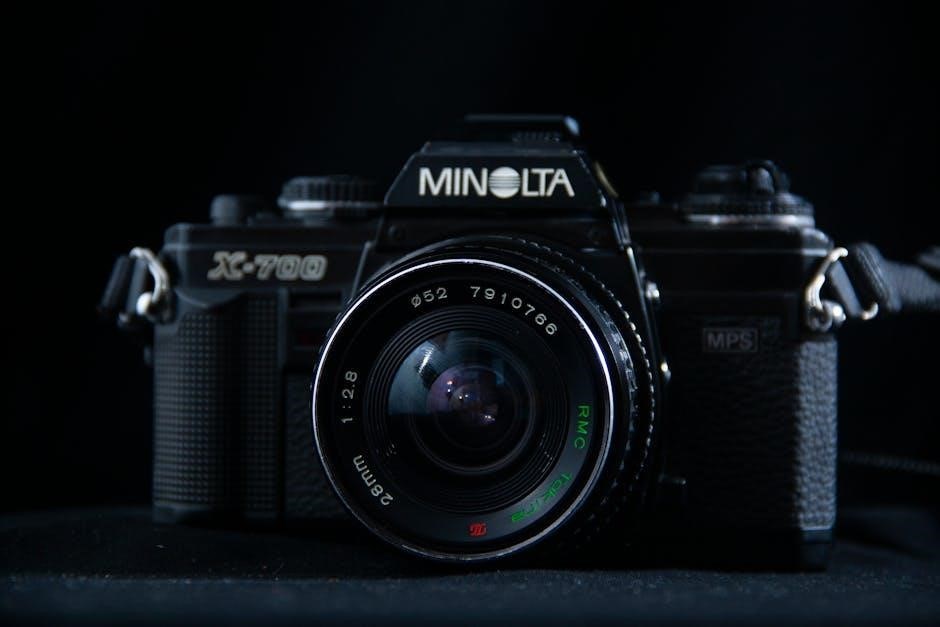
Troubleshooting and Maintenance
Troubleshooting common issues like shutter malfunctions or inaccurate metering ensures optimal performance. Regular cleaning of the lens and camera body maintains functionality. Refer to the manual for detailed maintenance schedules and solutions.
Common Issues and Solutions
Common issues with the Minolta Maxxum 7000 AF include shutter malfunctions‚ inaccurate light metering‚ and autofocus errors. For shutter problems‚ ensure the camera is properly powered and free from dust. If metering is off‚ check exposure compensation settings or clean the light meter sensor. Autofocus issues may stem from dirty lenses or misaligned mirrors; clean the AF sensor and ensure lenses are securely mounted. Film advancement problems can be resolved by checking for jammed film or improper loading. Always refer to the manual for specific troubleshooting steps. Regular maintenance‚ such as cleaning the camera and lenses‚ can prevent many of these issues. If problems persist‚ professional servicing may be required to restore optimal functionality. Proper care ensures the camera continues to deliver exceptional results.
Cleaning and Maintenance Tips
Regular cleaning and maintenance are essential to ensure the Minolta Maxxum 7000 AF performs optimally. Use a soft‚ dry cloth to wipe the camera’s exterior and avoid harsh chemicals. For the viewfinder and LCD‚ use a microfiber cloth to prevent scratches. Clean the lens with a soft-bristle brush and microfiber cloth‚ and apply lens cleaning solution sparingly. The image sensor area in the film compartment should be cleaned with a soft-bristle brush or an air blower to remove dust. Store the camera in a cool‚ dry place away from direct sunlight to prevent moisture buildup. Use silica gel packets to maintain dryness. Replace batteries annually if unused for extended periods. Regular maintenance ensures longevity and preserves image quality. Always handle the camera with care to avoid damage and maintain its reliability.
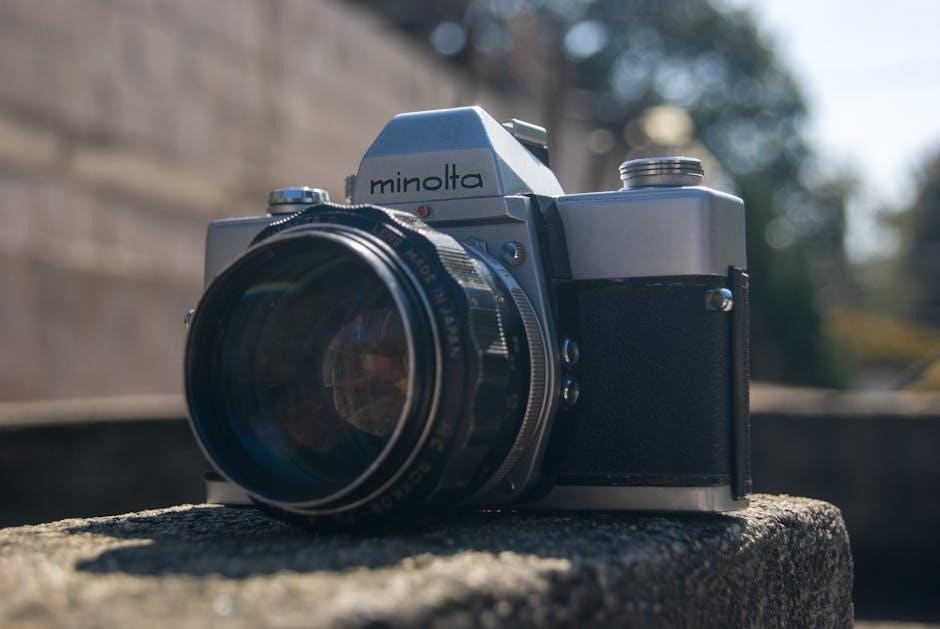
Legacy and Impact
The Minolta Maxxum 7000 AF left a lasting mark on photography‚ blending innovation with reliability‚ and influencing both film and digital camera design for years to come.
The Role of the Minolta Maxxum 7000 in Film Photography
The Minolta Maxxum 7000 AF played a pivotal role in advancing film photography during the 1980s. As the first commercially successful autofocus SLR‚ it revolutionized the industry by making autofocus technology accessible to both professionals and enthusiasts. Its ergonomic design‚ coupled with features like Program‚ Aperture Priority‚ Shutter Priority‚ and Manual modes‚ empowered photographers to achieve precise control over their work. The camera’s reliability and intuitive interface made it a favorite among photojournalists and wedding photographers‚ who relied on its speed and accuracy in dynamic shooting environments. Additionally‚ its compatibility with a wide range of Minolta AF lenses expanded creative possibilities‚ ensuring versatility for various photographic genres. The Maxxum 7000 not only enhanced the efficiency of film photography but also set a benchmark for future camera designs‚ leaving an indelible mark on the evolution of photographic technology.
Its Influence on Modern Camera Design
The Minolta Maxxum 7000 AF significantly influenced modern camera design by pioneering autofocus technology and ergonomic advancements. Its introduction of in-lens autofocus motors set a precedent for future SLR and mirrorless systems‚ while its multi-mode exposure system (PASM) became a standard in camera design; The intuitive control layout‚ including the rear command dial‚ inspired later models across brands. The Maxxum 7000 also popularized the concept of a camera system with interchangeable lenses‚ encouraging manufacturers to develop extensive lens ecosystems. Its compact and durable design philosophy continues to shape modern DSLRs and mirrorless cameras. Additionally‚ the camera’s emphasis on user-friendly features and advanced metering systems laid the groundwork for the sophisticated autofocus and AI-driven technologies seen in today’s cameras. The Maxxum 7000’s legacy is evident in its enduring impact on both film and digital photography equipment.
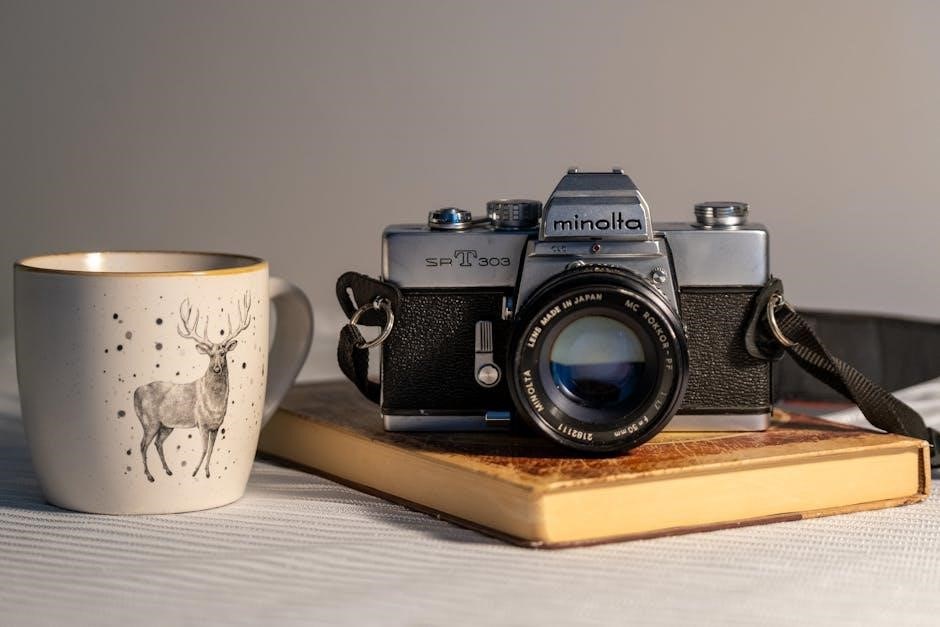
Downloading and Using the Manual
The Minolta Maxxum 7000 AF manual is readily available online as a downloadable PDF‚ providing detailed guidance for optimal camera use and troubleshooting;
Where to Find the Minolta Maxxum 7000 AF Manual Online
The Minolta Maxxum 7000 AF manual can be easily found online through various reliable sources. Official Minolta websites and trusted camera forums often host downloadable PDF versions of the manual. Additionally‚ digital archives like ManualsLib or ManualsOnline provide free access to user guides for vintage cameras. Photography enthusiasts and vintage camera communities also share scanned copies of the manual on platforms like Flickr or specialized forums. When searching‚ use keywords like “Minolta Maxxum 7000 AF manual PDF” or “download Minolta 7000 AF manual” to locate the document quickly. Ensure you verify the legitimacy of the source to avoid downloading malicious files. Many enthusiasts recommend checking multiple sources to find the highest-quality scan or most complete version of the manual.
How to Use the Manual Effectively
To maximize your experience with the Minolta Maxxum 7000 AF‚ it’s essential to use the manual thoughtfully. Begin by reading through the entire document to understand the camera’s layout and features. Pay special attention to the autofocus system‚ exposure modes‚ and metering options‚ as these are key to capturing high-quality images. Use the index to quickly locate specific topics‚ such as troubleshooting or maintenance tips. Practice the techniques described‚ like adjusting ISO settings or using flash effectively‚ to familiarize yourself with the camera’s capabilities. Refer to the manual regularly to refine your skills and explore advanced settings. By following the guidelines and experimenting with the camera‚ you’ll unlock its full potential and enhance your photography skills. Regular review of the manual ensures you stay informed and confident in using the Minolta Maxxum 7000 AF to its fullest extent.
Related posts:
Get the Minolta Maxxum 7000 AF manual for expert guidance. Learn advanced features, settings, and troubleshooting tips. Download your free PDF now!
Posted in Manuals